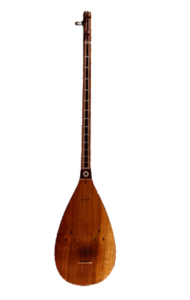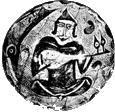 Tanbour (Tanbur, Tenbur, Tembur) has a pear shaped belly and a tall neck, over which ten to fifteen rifts could be tied. The front surface of the belly is of wood. The long neck, like Setar, is attached to the head, and the head, in fact, is the extension of the neck. On the front and the sides, there are knobs over which the strings are tied. In the old days, strings consisted of two, but nowadays there are three strings, tied over the knobs. Some even tie six strings in order to draw stronger sound.
Tanbour (Tanbur, Tenbur, Tembur) has a pear shaped belly and a tall neck, over which ten to fifteen rifts could be tied. The front surface of the belly is of wood. The long neck, like Setar, is attached to the head, and the head, in fact, is the extension of the neck. On the front and the sides, there are knobs over which the strings are tied. In the old days, strings consisted of two, but nowadays there are three strings, tied over the knobs. Some even tie six strings in order to draw stronger sound.
Today’s Tanbour-strings are three, and usually winded in various distances from each other. Fingers, without a plectrum, play the instrument. As stated in the History of Music of Iran, in the old days, there existed verities of Tanbour. For example, it’s been said that Iran’s famous Music theoretician, Farabi, categorized Baghdad Tanbour and Khorasan Tanbour.Tanbour or Tambur is a String Instrument; strings are walked over a long neck and a belly; they respond to the touch of the fingers.
 Nowadays, Tanbour could be categorized as a local instrument that has a taller neck and bigger, more rounded belly than Setar. It has two or three strings and fourteen frets, on octave intervals. Its especial effects aren’t observed in performance of Dotar. Tanbur is played by five-fingers; another sign that Tanbour and local Dotar and Setar belong to the same family, resonating by the touch of fingernails.
Nowadays, Tanbour could be categorized as a local instrument that has a taller neck and bigger, more rounded belly than Setar. It has two or three strings and fourteen frets, on octave intervals. Its especial effects aren’t observed in performance of Dotar. Tanbur is played by five-fingers; another sign that Tanbour and local Dotar and Setar belong to the same family, resonating by the touch of fingernails.
In Iran’s Western regions, especially among the Tanbour Players Association, Ahl’e Tarighat Dervishes and Qalanders, Kurdistan, Kermanshahan, and Azerbaijan’s Ahl’e Haq, Tanbour is popular; Ritual Music is performed with Tanobur.In the Northern parts of Iran, Northwest of Gilan province, a version of Tanbour called Taleshi Tanbour is played in Taleshi people Rituals.
Based on what was depicted on one of the three little statutes found in Shush Ruins, Tanbour dates back to one thousand and five hundred year B.C.
Once, Tanbur would be made in all varieties. In Iran and Syria, it would have a pear shaped belly; it would be exported through Turkey and Greece to the Western countries. It’s oval-belly version was popular in Egypt.
 Tanbour is mentioned as Iran’s Ancient Setar, played in Sasanid time (Khusraw Parvēz) and in the periods prior to that.Tanbour is known as the Iranian musicians instrument. Ebn Khordad’beh stated that in Ray, Tabarestan, and Daylam, people sang to the tune of Tanbour, and valued Tanbour more than any other instrument.
Tanbour is mentioned as Iran’s Ancient Setar, played in Sasanid time (Khusraw Parvēz) and in the periods prior to that.Tanbour is known as the Iranian musicians instrument. Ebn Khordad’beh stated that in Ray, Tabarestan, and Daylam, people sang to the tune of Tanbour, and valued Tanbour more than any other instrument.
In ancient scriptures, Tanbour is mentioned as an instrument most satisfactory to accompany songs, and it’s called Iran’s long-necked lute.
